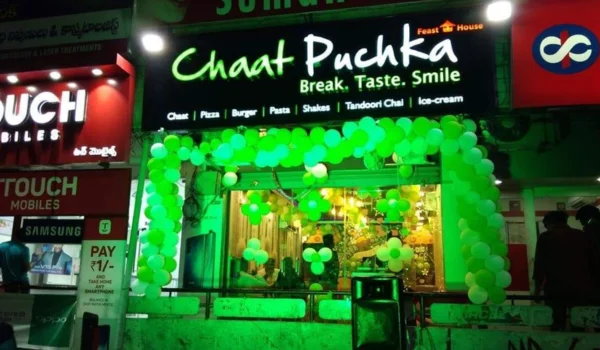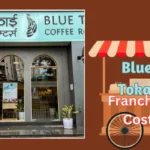Chaat Puchka is an Indore‑based fast‑food franchise launched around 2017–18, specializing in hygienic, standardized Puchka (Pani Puri/Golgappa) and chaat snacks in a quick‑service format. It aims to offer flavored and consistent street‑food across India, now operating over 60–150 outlets across 20+ states.
💰 Franchise Cost & Investment Breakdown

Estimated Investment & Fees
| Component | Estimated Cost (₹ Lakhs) |
| Franchise Fee | ₹3–4 Lakh + GST |
| Equipment & Machinery | ₹1.5–2.5 Lakh |
| Interior & Shop Setup | ₹2–3 Lakh |
| Opening Stock & Raw Materials | ₹1–1.8 Lakh |
| IT Systems, CCTV, Miscellaneous | ₹0.4–0.5 Lakh |
| Total Investment Range | ₹9–12 Lakh (typical single‑unit) |
| Space Requirement | ~200–350 sq.ft |
| Royalty / Revenue Sharing | 5% of gross sales / ~40% to franchisor |
| Franchise Agreement Tenure | 5 years, renewable |
| Payback / ROI Period | ~12 to 18 months |
According to FranchiseKhoj, the flagship model requires near ₹8.8 L for ~200 sq.ft unit, including ₹3 L franchise fee, ₹3 L interiors, ₹1.3 L raw‑material, and ₹0.5 L IT & misc, plus equipment cost ~₹1 L. Royalty is ~5% with ROI expected in 12–14 months.
FranchiseIndia and FranchiseGuru report total investment between ₹10–13 Lakh, franchise fee ~₹3–4 L, royalty ~5%, and gross margin around 60%, indicating franchisee retains ~60% of revenue. ROI projected within 1.5 years.
Franchisecapitals places total investment around ₹10.9 L, with equipment ₹2.2 L, opening kit ₹1.8 L, store setup ₹2 L, branding ₹0.5 L, IT systems ₹0.4 L, franchise fee ₹4 L, and 5% royalty.
TopFranchise lists Chaat Puchka as ranked #2 among India’s top 5 street‑food franchises, estimating initial cost ₹7–10 L and royalty 5 %.
🏢 Franchise Model & Operational Support
- FOFO (Franchise‑Owned, Franchise‑Operated) model: Franchisees manage daily operations while HQ supervises quality and compliance.
- Unit Formats:
- Compact kiosk or food‑court unit (~200‑250 sq.ft)
- Small standalone QSR (~300‑350 sq.ft)
- Larger store formats up to 1,000 sq.ft in premium locations (rare). Most single‑unit starts around 250‑350 sq.ft.
- Support Includes:
- Location/site evaluation
- Interior layout & branding guidance
- SOPs, staff training & kitchen operations
- Raw‑material supply (flavored water, pani bases, chaat ingredients)
- POS / IT system setup and aggregator integrations (Zomato / Swiggy)
- Local marketing collaterals and initial promotional campaigns
- Post‑launch support and field visits.
📊 Estimated Financial Performance & ROI
- Gross margins are estimated at ~60%, so franchisees retain ~60% of gross sales.
- Net margins after royalty, rent, salaries, and consumables could range ~20–30% in efficient units.
- Break-even or ROI projection: typically 12–18 months, depending on location. Some sources say up to 1.5 years.
Example: A unit earning ₹10 L/month revenue → franchisee net ~₹6 L (60%) → after 5% royalty ~₹5.7 L; operating cost ₹4 L → profit ₹1.7 L/month → full payback on ₹11 L investment in under 9 months. Actual payback may vary based on sales.
✅ Eligibility Criteria & Ideal Franchisee Profile
Prospective franchisees should ideally have:
- Investment readiness of ₹9‑13 Lakh plus working capital reserve for 3‑6 months operations.
- Location control: access to 200‑350 sq.ft commercial unit in high foot‑traffic zones (food courts, malls, highways, markets, campuses).
- Entrepreneurial drive and willingness to follow SOPs; prior F&B experience beneficial but not mandatory.
- Operational bandwidth: ability to hire/train 4‑5 staff members, manage inventory, and ensure compliance.
- Brand fit & hygiene discipline: upholding brand standards and taste consistency.
Documents usually required include proprietor PAN, Aadhar, GST/TAN registration, shop NOC/lease copy.
📝 Step‑by‑Step: How to Apply
- Initial Inquiry: Visit Chaat Puchka’s official site or franchise portals (FranchiseIndia, FranchiseKhoj); submit form with name, investment capability, preferred location.
- Pre‑screen & Discussion: Share your space, business intent, capital. Brand evaluates and provides franchise kit.
- Site Visit & Feasibility: Brand team may scout or evaluate foot traffic, competition, lease terms.
- Franchise Agreement: Review terms—5‑year renewable contract, royalty structure, territory exclusivity, raw material purchase obligations.
- Pay Franchise Fee (~₹3‑4 L + GST), sign agreement.
- Build‑out: Interior, kitchen setup, equipment, signage per brand guidelines.
- Training & POS Setup: On‑site or centralized training for staff; install IT systems and delivery tie‑ups.
- Soft Launch & Marketing: Initial promotions, local campaigns, aggregator onboarding.
- Operations & Support: Ongoing follow‑up support, SOP compliance checks, periodic menu updates, marketing guidance.
⚖️ Pros & Cons for Prospective Investors
✅ Advantages
- Low initial investment (~₹9‑13 L) compared to larger QSR brands.
- Solid brand support: SOPs, supply chain, marketing, tap into aggregator platforms.
- Quick ROI window: 12‑18 months if footfall and execution are strong.
- High gross margins (~60%) and franchisee share.
- Easy scalability: small format is replicable across Tier‑II/III cities.
❌ Caveats
- Franchise margins and ROI are highly location- and execution-dependent.
- Franchise fee and royalty apply regardless of initial sales.
- Control over operations is limited; must follow brand’s SOP strictly.
- Food business faces high failure rates if operational discipline is low. Reddit entrepreneurs caution: franchise failure is common without adequate backup and planning.
- Territory overlap, brand quality consistency across outlets can vary.
💡 Expert Advice & Best Practices
- Visit multiple existing units to assess service quality, taste consistency, and location mix.
- Negotiate rent tenure and escalation caps—rent is often the biggest overhead.
- Clarify agreement terms fully: exit clauses, renewal cost, raw-material sourcing obligations, territory rights.
- Plan staffing retention: typical attrition in F&B requires strong training and SOP adherence.
- Keep backup capital to support initial months without breakeven.
🧾 Franchisee Quick Checklist
- ₹9–13 L investment + 3–6 month buffer
- 200–350 sq.ft space in high footfall zone
- 4–5 trained staff members
- 5‑year renewable franchise agreement, 5% royalty
- SOP‑compliant branding, supply chain, POS & aggregator tie‑ups
- Willing to follow training and quality protocols
🎯 Final Verdict
Chaat Puchka presents a compact, focused franchise opportunity in India’s fast‑food street‑snack segment. With relatively low investment, a strong margin model (~60%), and full operational support, it can deliver ROI within 12–18 months in well‑chosen locations and disciplined execution.
If you’re entrepreneurially minded, have access to small high‑footfall real estate, and committed to brand adherence, this franchise can be a scalable and rewarding venture. Yet, keep in mind that franchise success in food is never guaranteed—location, consistency, and operational rigor matter most.

Shashi Kant is the Founder and Editor of BusinessScroller.com, a leading platform for business insights, finance trends, and industry analysis. With a passion for journalism and expertise in business reporting, he curates well-researched content on market strategies, startups, and corporate success stories. His vision is to provide valuable information that empowers entrepreneurs and professionals. Under his leadership, BusinessScroller.com has grown into a trusted source for in-depth articles, customer care guides, and financial expertise.


